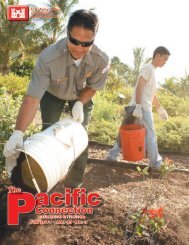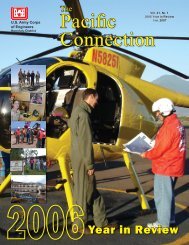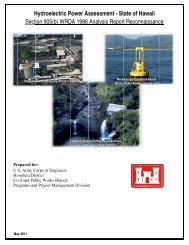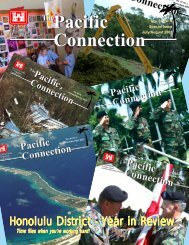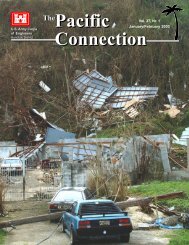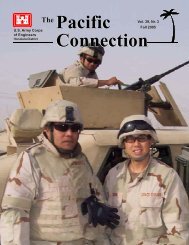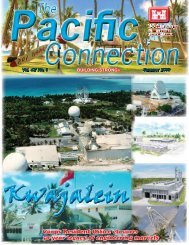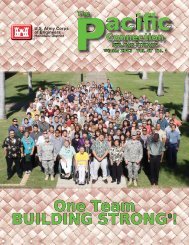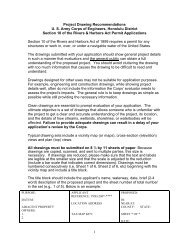The Pacific Connection - Honolulu District - U.S. Army
The Pacific Connection - Honolulu District - U.S. Army
The Pacific Connection - Honolulu District - U.S. Army
Create successful ePaper yourself
Turn your PDF publications into a flip-book with our unique Google optimized e-Paper software.
6 <strong>The</strong> <strong>Pacific</strong> <strong>Connection</strong> Centennial Edition 1905-20051921 - 1929Calm Before <strong>The</strong> Storm<strong>The</strong> 1920s were not exactly roaring for the <strong>Honolulu</strong> Engineer <strong>District</strong>. As WW I military projects and civil works surveys werebeing wrapped up, HED built roads and laid an underground cable almost all around the island for fire control.HED’s work load did increase after the Naval Conference of 1921-1922 called for a moratorium on capital ship building. Thismoratorium allowed the Navy to transfer four of its surplus 16-inch guns to the <strong>Army</strong> in Hawaii. HED constructed batteries for the newguns at Ewa and the North Shore along with the necessary support facilities and machinery such as railroads, locomotives, power plants,magazines plotting and switchboard rooms.HED saw an increase in civil work projects in 1925 after the Treaty of 1922 prevented the U.S. from fortifying the Philippines, Guamor Wake. Hawaii could now receive the funds and the <strong>Army</strong>’s undivided attention necessary to improve its harbors and defenses. Hawaiialso had the advantage of local business support for many of the harbor improvement projects-including three pineapple companies whoagreed to pay for the initial dredging of Reserved Channel.In 1926, HED’s missions once again changed when HED’s <strong>District</strong> Engineer no longer had to wear two hats - jettisoning the titleof Hawaiian Department Engineer.1920s Milestones1921: HED built the Nawiliwili Harborbreakwater in Kauai and beganenlarging its entrance channel andharbor basin.1922: HED moves to the new <strong>Honolulu</strong>Federal Building at Richards andMerchant Streets.1922: Completed the concrete EngineerWharf at <strong>Honolulu</strong> Harbor.Sept. 1924: Williston Battery atIroquois Point in Ft. Weaver is completed.1927: Reserved Channel createdwhich divides Sand Island from the<strong>Honolulu</strong> waterfront.Ft. Shafter’s Palm Circle, circa 1920: Today,the area is designated as a historical landmark.Military families enjoy the swimming tank at Fort DeRussy in 1924. In 1911, a deep channel was dredged throughthe reef in front of Ft. DeRussy to facilitate the installation of the 69-ton guns at Battery Randolph. This dredgedchannel served as a swimming tank for Soldiers and their families. Lt. John Slattery, HED’s first DE, purchasedthe 74-acre Ft. DeRussy for just $2,700 an acre as a military fortification. Today the area is a major recreationarea for the community with a park, jogging trail, the U.S. <strong>Army</strong> Museum, the USACE <strong>Pacific</strong> Regional VisitorCenter and the Hale Koa Hotel.(L & R) Oahu’s firstcoastal fortification,Battery Harlow at Ft.Ruger, circa 1924: HEDbuilt Battery Harlow in1910 at Diamond Head.Its eight 12-inch gunswere contained in twoconcrete pits which werepraised for their strength.When the guns were testfired,only one smallcrack appeared in theconcrete.



